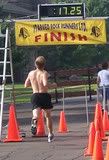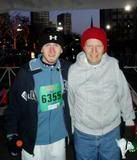Does running make you stonger?
A) Yes!
B) No!
C) Uhhhhh, you didn't say there was going to be a quiz!
D) Shut up, stinky, you should take a shower before you blog!
The correct answer is...
...
...
...
...
...
...
B! No. Running does not make you stronger. Recovering from running makes you stronger! Let me give you a quick example as proof. You just ran four 1 mile repeats at a very strong effort. Could you immediately repeat the same workout again? No, of course not! The workout made you weaker for the time being, but as you recover, your body builds back stronger.
What if you don't let it rebuild?
Injury. Illness. Lack of energy. Dead legs. Grouchiness. Burn out.
We've all been there, I'm sure of it. Whether it has been caused by sudden good weather, peaking for a marathon, a new ambitious running partner, or any other reason I've missed -- It sucks. It's something to be avoided at all costs, if we'd like to continue to reap the health and fitness gains from our commitment to running.
There are two key ways to avoid these negative effects: Decrease the time it takes to recover or increase the time spent recovering. Easy enough, right?
Decreasing the time it takes to recover is the route most runners want to take. Faster recovery equates to more miles/higher intensity equates to better performance come race day. Although these are intuitive, they're easy to overlook. The main idea here is recovery happens during those 22-23 hours every day you aren't running! Here are some tips to decrease your time to recover:
- Sleep more. Make it a priority to get 1 more hour of sleep every day (either at night, or with a nap) and your running will reap the benefits
- Eat healthy. Food = fuel. This is especially important before or after a hard day. What fuel would you rather burn on a fast or long run: ice cream or pasta? See Heidi's post and everything she links to. It's full of great information!
- Eat to recover. As soon as you finish a run, eat! The 30 minutes following a run your body is begging for nutrients, and it soaks them up like a sponge. Take advantage of this.
- Stay hydrated. Always have a water bottle with you to sip from. Being well hydrated will help your body repair itself.
- Get a massage. Obviously this isn't something to be done frequently (unless you have a money tree), but getting a massage every month or two can really help recovery after a hard week of training.
- Increase your mileage slowly. As your body gets used to more miles, it recovers from them more efficiently since that is exactly what you're training it to do. However, if you increase too fast you're begging for all the symptoms of overtraining listed above!
- Take more time between workouts. Obvious, right? The only problem is we always want to run more. We don't want to take a day off.
- Take a 'fake' day off. This is for people who just can't take a day off from running. They're so horribly addicted that hell would very likely freeze over if they missed a run. For you guys, take a fake day off: One day run early in the morning, the next day run late at night. This gives your body 36+ hours to recover between workouts.
- Run easy. After hard workouts, your body needs the break. Don't underestimate the benefit of an easy run. Focus on relaxing for the entire run. Pfitzinger's book, Advanced Marathoning, advocates the idea of the Hard-Easy principle. You want to run to recover, rather than recover to run.





